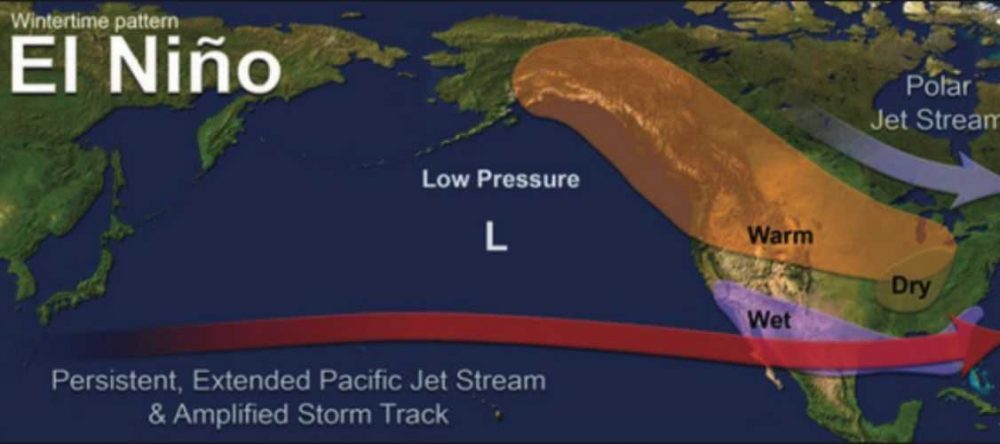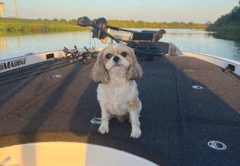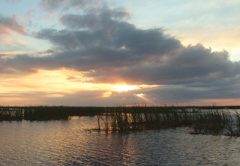In many locations around the world, 2016 will go into the record books as a massive El Nino event. El Nino, the weather phenomena known to bring heavy winter rains to Southern California and warm temperatures to the U.S. Northeast, is the result of vast amounts of warm Pacific water pushing eastward towards the western coast of South America. This pattern disrupts the normal upper atmospheric jet- stream pattern and for Florida this means a wet winter with unusually high thunderstorm and tornadic activity. In fact as of this writing, an El Nino driven storm just hit southwest Florida spinning off a tornado that kill two people during the night. The question is, does this weather pattern impact the bass in Lake Okeechobee and surrounding lakes?
A quick search on the web finds very little if any information on the impact of El Nino conditions on the local bass population. Unlike offshore species such as Mahi Mahi, Tuna, King Mackerel, Tarpon, and other migratory species, bass live in an enclosed system. They just can’t pick up their belongings and swim to Orlando for better living conditions. So they are stuck in the lake they live in and have to endure whatever El Nino’s weather brings their way. One would think this is really no big deal but the main impact of El Nino occurs during our winter months and this coincides with the primary spawning season of the local bass and panfish populations.
The Florida Bass is unique among bass species for they spawn over a very long period.
Depending on conditions the spawn could begin as early as October and last into May giving the bass 6 to 7 months to complete their duty. Typically local bass spawn in areas of shallow water including backwaters, channels and grass laden areas protected from strong winds and wave action. They usually look for areas with firm bottoms of sand, gravel, mud or rock and usually in water from 1-4 feet deep. The male will construct the nest by fanning out a pocket in the bottom with its tale and then await the arrival of the female. Once the female lays her eggs the male will remain with the nest to protect the eggs from predators.
The driving force influencing the spawn is water temperature. Local bass will begin to feel the urge to spawn when the light-dark cycle (sunlight) starts to decrease and the water temperature drops into the mid 70’s. As the water temperature reaches the mid 60’s the bass will begin their spawn. The incubation period of the egg is dependent on water temperature with an egg hatching in 2 days in temperatures of 70-degrees while taking 5-days or more when the water temperature is in the mid to upper 60’s. In south-central Florida bass eggs are viable from 58 to 85-degrees. Since water temperature impacts the fecundity of the egg, the bass will seek out the most desirable of conditions to build their nests. When the water is cold bass will spawn in very shallow water where the temperatures are the warmest. When water temperatures are warm, they’ll spawn in deeper waters.
With water temperature playing a major role in the timing and survivability of the spawn, the impact of El Nino begins to appear. Typically winter in Florida is the dry season. Cold fronts coming into the State from the north bring cooling temperatures but little rain. However during El Nino periods, the redirected jet-stream drives low pressure fronts over the mainland further south and into the Gulf of Mexico which in turn drops higher than normal amounts of rain in central Florida. These rains then enter the Kissimmee Watershed and eventually into Lake Okeechobee. This conveyor belt of storms brings dramatic swings in air temperature, barometric pressure, winds, water turbidity, lake levels, and enviably water temperatures.
WHAT WE DO KNOW IS THAT IT SURE PLAYS HAVOC ON OUR FISHING.
Whether these dynamic changes are strong enough to off-seat a sitting male bass is unknown and so too is the impact of these storms on the overall survivability of the spawn. What we do know is that it sure plays havoc on our fishing.
It’s common knowledge that changing weather changes a bass’s behavior. Bass are known to prefer stable weather. In addition to providing a comfortable living environment, stable weather also concentrates the bass’s food source. So when a front moves through there is a disruption to the bass’s environment and its food supply which forces the bass to make adjustments. These ‘adjustments’ frequently result in a condition referred to as ‘lip locked’ where no matter what you entice a bass with, they’re not going to bite.
So what should you do to improve your chances during these frequent El Nino spun storms? That will depend on where and when you fish. If you can, fish just prior to the arrival of the low pressure front. The fish will be feeling the change in pressure and will begin an aggressive feeding period as well as begin the move to deeper water. Fish transition areas like trails in the weeds, channels, weed-line edges, and sloping underwater structure. As the storm approaches, become aggressive with your baits. Upsize your lures and increase the speed of your retrieve. Water conditions will most likely be taking a turn for the worse and the bass will rely more on their lateral line to detect the vibrations of potential food so make some noise.
After the front pushes through and you’re left fishing the sunny skies and high pressure that immediately follows the front, then it’s time to slow down and fish deep. Bass will most likely be in a hunkered down mode. First you’ll need to locate them so look for safe havens such as deep channels, drop-offs, brush piles, and deep thick vegetation. If the storm front brought good rains then look near incoming water such as spillways, incoming streams, ditches, and culverts. Use smaller crank baits, stick baits, spinnerbaits and swimbaits to locate the fish and then change up and slow down. Switch to slow moving baits such as jigs, plastic worms, craws, and flukes. The bass most likely won’t be in a feeding mood so you’ll have to piss them off in order to get them to react. After about two days or so, unless another front has pushed through, conditions should have improved and the bass will return to their normal seasonal pattern.
It’s wildly known that winter in Florida offers the best opportunity to land a trophy bass. The females are moving in and out of the spawning beds while the males stay behind to defend the roost. While the impact of El Nino on the spawn is unknown we do know that the increase in storm activity will increase the movement of the bass thus making catching a trophy fish much more likely. So check the weather, pack your rain gear, and if it looks good, then GO FISHING.
[easy-social-share]







